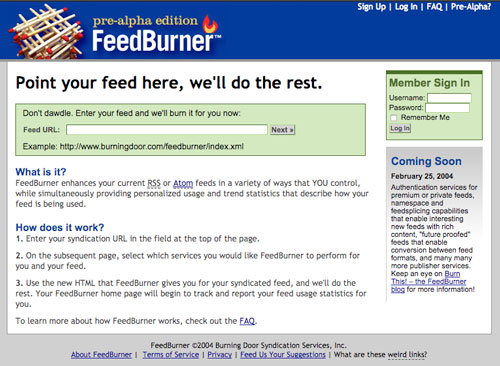Google’s Zombie
Why FeedBurner, a service that Google once bought for $100 million, has become the one service it literally can’t kill. Here's why the service lingers.
Tonight's GIF comes from a video from ASMRSurge, a YouTuber who focuses on relaxing sounds.
“I’ve come around to the view that Google will eventually start managing feeds and monetizing feeds as another way to promote AdSense.”
— Dick Costolo, FeedBurner’s cofounder and CEO, making the case in an interview with Business 2.0 that Google would eventually become competition for his company, which monetized RSS feeds and added analytics features. Just a year after the interview, Google bought FeedBurner for $100 million and did exactly that.

The basic idea behind FeedBurner that made it so powerful
The RSS feed, when it came to life, was a powerful idea, one that made data portable without the added weight of the surrounding web page.
But while the spec was valuable, and one that filled millions of RSS readers the world over, publishers didn’t have a massive amount of control over the information that was pushed through these services.
Sure, you could run analytics software through your website, but what were you supposed to do when you wanted to track how many readers got an eyeful of your latest navel gaze?
And what about making it possible to share content? Or run ads against your words? Publishers will feel like they’re getting shortchanged if they offer their content for free without a way to pay for all that distribution.
Sure, this could all technically be done within the RSS specification, but it was confusing to the layperson.
Hence, why an application like FeedBurner needed to come into existence. It was an appealing pitch in 2004: Shove your website’s RSS feed into this service, tell people to use feed instead of the one on your website, and we’ll give your feed superpowers.
The service was launched by a group of friends who had spent time at Andersen Consulting, a firm that is now known as Accenture, in the 1990s. The company was the product of four smart minds—and the one who’s the best-known of the four today, Dick Costolo, was actually more focused on his comedy career at the time and largely using a day job to help pay for his theater work.
But Costolo, along with his coworkers Steve Olechowski, Matt Shobe, and Eric Lunt, saw that the web was becoming a big thing—but that Andersen Consulting wasn’t interested. So, they launched an array of companies, with one of those firms, the website tracking service SpyOnIt, selling to 724 Solutions for $53 million in 2000.

What FeedBurner looked like upon its 2004 launch.
FeedBurner wasn’t their first company. It wasn’t even their first hit. But it had impeccable timing. The service launched just as RSS was starting to gain some real momentum, in particular as podcasting gave RSS a use case that didn’t seem quite so niche.
And the company grew fast, too. By 2007, it was hosting more than 800,000 individual feeds and 471,000 publishers, up from just 5,600 three years prior.
In a 2006 interview with Business 2.0, Costolo spoke of the importance of network effects of the platform thanks to all that scale, suggesting the idea of even combining popular feeds into “affinity groups” that users could follow, as well as organizing feeds for end users.
“You put your tags in Del.icio.us, your photos in Flickr, your friends in AIM; you have a blog, a podcast, etc.,” he told the outlet. “And we splice it all together into a single feed.”
Some aspects, of course, were controversial. FeedBurner’s ads were seen as quite problematic at first, as highlighted by this 2004 Wired article that reads as a who’s-who of the 2004 blogosphere. (Andy Baio? Check. Matt Haughey? Check. 37Signals? Double-check!)
Olechowski was quick to defend the approach.
“A lot of these publishers have a business model of ads on their HTML sites, and a lot of people read a lot of the same content in the RSS feeds and never go to the HTML website,” he told the magazine.
Ultimately the ads, and the service, stuck around. Though you can’t exactly say that they thrived.
“When FeedBurner first came online I warned that there was danger in giving so much power to one company. … I've been around this business a long time, and I was sure their strategy was to sell to a bigger company, and I don't trust big companies.”
— Dave Winer, a key figure in the early development of the RSS specification, discussing his concerns about FeedBurner in a widely shared 2007 post, timed around Google’s $100 million acquisition of the company. He noted that he held his stance against the tool despite facing criticism, and despite the company suggesting that it was never its goal. On the other hand, others credited FeedBurner for trying to build a functional business model around RSS. As Matt Marshall wrote for VentureBeat in 2007, FeedBurner’s analytics and sharing features were “imperfect and sometimes extremely frustrating to figure out. However, FeedBurner deserves credit for going down this path first. Few others have followed.”

The issue with RSS that makes FeedBurner difficult to kill outright
In 2012, five years after the company spent $100 million buying out FeedBurner, Google was already well-known as being a murderer of ideas. And FeedBurner was already looking a little shaggy and unloved.
That was the year the company stopped posting on its AdSense for Feeds blog—reflecting the eventual death of that service.
“Thanks to everyone who has been a loyal reader of this blog over the years,” blogger Emily Wood wrote in July of that year. “After some consideration, we recognize that we’re just not generating enough content here to warrant your time, so we won't be posting here any longer. Thanks again for being an enthusiastic FeedBurner user.”
The company, over the years, has acquired at least 220 other companies, according to CrunchBase. (Considering the hiring tear it was on around 2011 or so, that may be a conservative estimate.) Some of the acquisitions are household names like YouTube or fundamental tools like DoubleClick. Others, like Urchin (later Google Analytics), found a second life as another Google product. But numerous others have fallen into the ether, never to be seen again—for example, 60db, which was shut down just last month, and Apture, which disappeared in 2011.
And Google itself has killed plenty of promising internal ideas, from Google Wave to the original version of Google Glass.
This, of course, is not an uncommon state of affairs in the tech industry. Move fast, break things. That’s why it raises an eyebrow when a service is merely left alone and ignored under a giant corporate structure, like FriendFeed was at Facebook. That service, which shut down in 2015, was allowed to live for six full years with few, if any updates.
And Google eventually did take aim at RSS platforms as a whole, infamously shutting down Google Reader, in a move that was widely derided and may have been one of the most controversial in Google’s entire history.
At the time of that 2013 move, TechCrunch reporter Frederic Lardinois implied FeedBurner might be next. (“I can’t imagine that Feedburner will live through many more of these spring cleanings given that it is Google’s last RSS-focused product that’s still standing,” he wrote at the time.)
They weren’t running ads against all that RSS content anymore—so what’s the point?
But here’s the problem. RSS is plumbing. It’s nice to put into your home when you’re building it, but it’s hard to pull out. And if Google pulls out that plumbing, suddenly a whole lot of RSS feeds—which are used for numerous other reasons besides simply reading—become useless. Podcasting, of course, is designed around them. So is a whole lot of website distribution. Many of the posts at Twitter, for example, end up there because they’re being directly syndicated from RSS.
(Costolo, of course, moved on from FeedBurner to become Twitter’s CEO for a few years. He’s now the CEO of a company called Chorus.)
When FeedBurner made the case all those years ago to convince publishers, podcasters, and bloggers to use its service, it was basically making a simple argument: Let us be your middleman of choice.
It was a compelling argument because few companies were seriously doing anything like what FeedBurner was at the time, which made it valuable.
But now, Google is stuck. If it turns off this service, it could hurt thousands or even hundreds of thousands of sites that bought into this promise a long time ago and have no easy way out of what’s become a bad deal. They can redirect their feeds, but that’s not intuitive in the FeedBurner interface, and many older sites may not get the memo. It’s one thing to break the glasses everyone uses to drink out of; it’s another thing entirely to remove the pipes.
So Google lets it live, only paying attention when enough people complain that its features randomly stopped working or that one arbitrary decision by Google led something else to break.
It didn’t take very long for Dave Winer to be proven right.
As you may or may not know, Tedium does have an RSS feed (it’s at feed.tedium.co). It’s the same feed that’s followed me around since my ShortFormBlog days. Some of my readers have been around for more than eight years.
And I was stuck on FeedBurner for a while myself, and it annoyed me, to be honest. Fortunately, we’re not completely stuck with terrible options anymore. I use FeedPress, which costs money but I recommend, though there are plenty of others, like Feedity and Feedio. (You can always go back to your old RSS or Atom feed, of course.)
And it’s entirely possible that maybe we’ll move to something else entirely; there’s a recent movement in the tech community to start putting website feeds into JSON format, the same format used for developer APIs.
Whatever happens, though, the value of RSS (and its competitor Atom) reflects an era in which everything wasn’t quite so centralized—when individual site owners, rather than the platforms they used, held all the power.
In other words, this plumbing is one of the last vestiges of the Old Web. Best to keep it strong.
:format(jpeg)/2017/11/tedium111417.gif)
/2017/11/tedium111417.gif)

/uploads/ernie_crop.jpg)